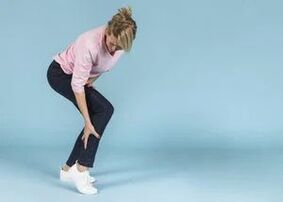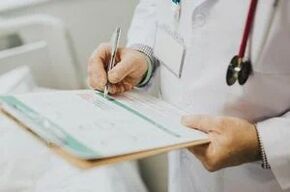Angiosuri claim that varicose veins are such a pathological process, resulting in the venous wall changes with a subsequent valve deficiency.
Reasons
The exact causes of varicose veins are not yet known.Based on epidemiological studies, it has been found that genetic predisposition affects the pathological process.

Predisposing factors are also known from which varicose veins can appear:
- Hormonal background disorder (menopause, estrogen intake);
- overweight;
- pregnancy;
- long static loads;
- wearing narrow underwear;
- constipation;
- surgery (arteriovenous bypass);
- Defects of development or obstruction of deep veins.
What does it look like?
Because varicose veins are a modification of veins, the pathology is ranked not only on vascular diseases but also for cosmetic problems:
- Patients first notice the appearance of a venous leg model or the appearance of mesh veins.
- Later, the veins become convincing, lifting the skin.
- In the distant stages of varicose nodes, they are clearly visible, representing the confusion and expansion of the venous vessels.
Disruption of tissue trophism leads to a change in skin pigmentation.
Stages (degree)
Several stages or degrees, varicose veins are distinguished.In first -degree varicose veins, patients are diagnosed with severe leg syndrome.Often, patients complain of cramps in the calf muscles and swelling, which disappears after rest.
With varicose veins of grade 2, persistent edema appears, impaired skin pigmentation, stagnant dermatitis.In advanced cases, trophic ulcers occur in the 3rd degree of disease.
The value of prevention
Knowing the predisposing factors for the onset of the disease, one must pay attention to the prevention of varicose veins:
- wearing comfortable shoes and linen;
- minimization of labor associated with static loads and prolonged standing of the legs;
- physical education classes;
- Intake of vitamins: C, E, RP;
- Power adjustment.
If there is no way to change the work that causes the disease, it is recommended to unload gymnastics during the day and drainage massage in the evening.Wearing elastic bandages and contrast shower will help you avoid the disease.
Signs
The symptoms of varicose veins are varied.The clinical picture depends on the course of the disease and the location of the varicose process.
Coils
The initial signs of varicose veins are:
- weight in the legs;
- leg stress;
- tiredness when walking;
- Pastability in the ankle joint (often evening);
- Convulsions;
- Pain in the course of enlarged veins.
In women, symptoms increase before menstruation.After rest, the unpleasant sensations in the legs disappear.
Lymphatic deficiency in varicose veins leads to the development of cellulite, dermatosclerosis, trophic ulcers and erysipelas.With severe disorders of the venous outflow, patients complain of itching of the skin and dry skin in the area of the affected vein.
Gradually, at the site of disorder of the tissue trophism, the skin is sharper and atrophic.Hyper- or hypopigmentation develops.With the progression of the pathological process, cyanotic spots and trophic ulcers appear.

In a pronounced process, patients have complaints about:
- increased fatigue;
- heart rate;
- shortness of breath.
These signs are associated with increased loading of the heart muscle in connection with the deposition of blood in the venous line.
Reticular varicose veins of the lower limbs
A special manifestation of varicose veins are reticular varicose veins.Clinical manifestations of pathology:
- increase in local temperature in the ankle joint;
- fatigue and weight of the legs;
- Dense subcutaneous tissue.
Varicose veins of the esophagus
With the enlargement of the enlargement of the esophagus veins, conviction and bags with blood vessels appear.Portal hypertension is the main cause of the disease.
The disease is manifested by the following signs:
- esophageal inflammation;
- burning, landing;
- anemia;
- Difficulty to ingest food.
A dangerous complication of pathology is massive bleeding from the veins.The patient vomits with blood, hypotension, tachycardia, impaired consciousness.
Uterine varicose veins
The forms of internal varicose veins include varicose veins of the uterus.The main reasons for the change in veins:
- physical activity;
- chronic constipation;
- pregnancy;
- taking hormonal contraceptives;
- Developmental anomalies;
- Abortion.
Women with uterine varicose veins complain of pain in the lower abdomen, disruption of the menstrual cycle.The disease can lead to infertility.
Varicose veins of the pubic lips
This type of varicose veins in pregnant women can develop from the second month of pregnancy.The disease develops if there has been pelvic thrombosis or there is congenital angiodospasia.
What the varicose veins look like:
- varicose veins of the vulva;
- Combs on the skin as a result of itching;
- Swelling.
The disease is accompanied by disurious disorders that are cracked in the perineum.The danger is the development of acute thrombophlebitis, rupture of a damaged vessel.
Varicose veins on the pelvis
The first signs of varicose veins are pulling pain in the lower abdomen.There are several options for the course of this form of the disease:
- varicose veins and vulva;
- The pelvic venous knit.
The clinical manifestations of the pathology are observed in 30% of women during pregnancy.The disease is a purely female pathology.
The venous knit is manifested with the following signs:
- weight and pain;
- pain during intercourse;
- dysmenorrhea;
- Urination disorder.
Varicocele
Varicose of the seed cord in men is called varicocele.The disease leads to a disorder of the venous outflow of the testes.Patients complain of pain in scrotum, erectile dysfunction.During testicles, enlarged superficial veins, asymmetry of the scrotum, are visible.The causes of the development of the disease include:
- physical activity;
- congenital deficiency of connective tissue;
- Tumors in the retroperitoneal space or pelvis.
The progression of the pathology disrupts spermatogenesis, leading to infertility.The disease can be complicated by bleeding from the affected vessels.
Varicose dermatitis
In addition to the characteristic clinical symptoms of progressive varicose veins, its complication - stagnant dermatitis - should be noted.In patients, the skin over the affected veins begins to become sharper and itching.In places of inflammation, dark or light color and peeling appear.
The localization of venous dermatitis is the lower legs and ankle joint. In the combined pathological process, it is applied to healthy tissues.If the problem is ignored, the inflammation goes into expanded eczema.
Varicose eczema
Inflammation is stubborn with periods of remission and relapse.Skin lesions are treated greatly even after humans.Due to microcirculation disorders, the liquid part of the blood penetrates the walls of the affected vessels.In the area above the varicose vein, swelling and crying areas appear.
Bubbles filled with serous or serous blades appear on the legs.With combs, infection enters the wounds.Merging, small bubbles form papules.After opening the vesicles, crusts appear.The healing site is thin and covered with flakes.Vesicles appear during the exacerbation period.The progression of the pathology leads to the formation of trophic ulcers.
Pain as a sign of illness

Often, patients complain of pain in varicose veins, which is enhanced by palpation of the affected vessel.In the initial stages, the sign manifests itself slightly.One experiences weakness and pulls pain at the end of the day.In the morning, after rest, the symptoms disappear.In the late stages, the pain syndrome occurs at night.
A combination of pain and seizures at night or after prolonged standing of the feet is considered a classic manifestation of varicose veins.
Characteristic localization of pain in varicose veins:
- above ground region;
- Trophile ulcer area;
- The muscle of the calf.
If an increase in the overall temperature is attached, it may indicate the onset of the inflammatory process in Vienna - thrombophlebitis.
Vascular stars
Vascular stars are called Telagictasia.The pathology is manifested by the expansion of small subcutaneous vessels.The skin is manifested in the form of a network of purple or red vessels.The causes of telangiectasia can be not only a venous deficiency, but also: also:
- Connective tissue diseases;
- pathologies of the hepatobiliary system;
- use of hormonal drugs;
- Endocrine diseases.
The vascular network manifests itself on the legs, face or ass.Telioectasia is not a separate disease, but acts as a symptom representing a more cosmetic defect.
Face
The appearance of a capillary network is called rosacea.It occurs in the case of disruption of the rheological properties of the blood, with arterial hypertension or diseases of the digestive system, the negative effects of low temperatures or when drinking alcohol.
In women, the main cause of telangiectasia is hormonal restructuring.The gold standard for eliminating the defect is laser coagulation.
On the feet
On the feet, the vascular network occurs as a result of venous stagnation.Violet networks often accompany varicose veins.As Telangiectasia progresses, the disease progresses.Even after the veins are removed, the capillary network remains.The methods of its elimination are scleroderma, radio frequency ablation, endovasal laser coagulation.
How to get rid of?
Before getting rid of varicose veins, they are performed by complete diagnosis.Patients show laboratory methods for blood and urine testing, detection of reflux for subcutaneous veins, functional samples.Of instrumental techniques are appointed:
- Ultrasound duplex or triplex scanning;
- X -ray contract phlebography;
- magnetic resonance phlebography;
- Multiporal computer angiography with contrast.
After determining the degree of varicose veins, the issue of treatment methods - surgical surgery or conservative therapy.
Who treats?
If the first symptoms occur, you should contact the clinic to the phlebologist or angiosur. In district medical establishments, surgeons are involved in this disease.It should be understood that the experience and qualification of those who treat varicose veins play a decisive role in eliminating the problem.Therefore, it is better to contact specialized centers.
What treatment is needed?
The following basic methods are used with damage to the vessels of the lower limbs:
- operation;
- sclerosis therapy;
- Conservative treatment.

In advanced cases, the methods are combined.Chronic venous insufficiency with damage to the valve apparatus of blood vessels and signs of thrombophlebitis, the removal of the veins (phlebectomy) is indicated.Surgical intervention methods with the minimum nature of the invasion include:
- Thermal ablation of the veins: radio frequency, laser, microwave, steam;
- Non -genuine ablation: chemical with sclerosure drugs and mechanochemical.
To reduce the symptoms of the disease, systemic therapy is prescribed by medicines.Patients are prescribed:
- antibiotics for inflammatory processes and trophic ulcers;
- antiseptics;
- phleboprotectors;
- Stimulants for tissue reparation;
- anticoagulants;
- local steroids with trophic ulcers;
- Local use of heparin -containing drugs.
The condition for effective elimination of varicose veins is compression therapy with the help of elastic bandages, golf, tights.The popular method of dressing is zinc-vivatin dressing for trophic disorders.
What helps better?
The preparations and compression dressings (knitwear) are prescribed only by a doctor, taking into account the stage of the disease, its complications accompanying pathologies and the age of the patient.Therefore, what helps better with varicose veins should tell a phlebologist.
It should be understood that treatment with medicines alone will not eliminate the pathology, as well as carrying a compression knitwear.
Varicose veins in most cases are eliminated only surgically in combination with other methods of therapy.
How do I remove itching?
To get rid of itching with varicose veins, you need to know how to remove it.Doctors prescribe moisturizing therapeutic ointments (you can use baby cream).Severe itching and peeling of the skin are prescribed medication with hormones.
They use compresses with a decoction of herbs with anti -inflammatory effects (chamomile, calendula, sage, series, hop cones).
What is dangerous?
The effects of varicose veins include phlebitis, trophic ulcers, thrombophlebitis, menstrual disorder, erectile dysfunction, infertility.The formation of a thrombus and bleeding from the affected vessels is what varicose veins are dangerous.
The torn blood is prescribed by the lower limbs for a second fall in a small circle of circulation, causing thromboembolism of the pulmonary artery.
With bleeding without emergency medical help, one loses a lot of blood.All these complications lead to damage or death without adequate treatment.
Conclusions
Varicose refers to general pathology.It develops in people with hereditary predisposition with excessive static and dynamic loads, as well as their prolonged absence.
The disease leads to serious complications, so if the first signs occur, you need to contact a phlebologist.
You can only get rid of the problem with an integrated approach.
Patients show surgical methods of treatment, medicines, wearing knitwear compression and lifestyle adjustment.
